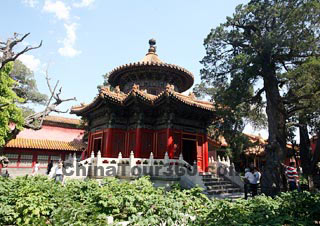Located between the Palace of Earthly Tranquility and the Gate of Divine Prowess, the Imperial Garden was originally built in the 18th year of Emperor Yongle’s reign in the Ming Dynasty (1368 - 1644). In later years, it was renovated several times. Every year, the imperial family celebrated the Double Ninth Festival and the Middle Autumn Festival in the garden. In between special occasions, it was a place for the emperors and their wives to rest and entertain. It was connected to the three palaces in the inner court through the Gate of Earthly Tranquility, and was interlinked with the Six Eastern Palaces and the Six Western Palaces through the Qiongyuan East Gate and Qiongyuan West Gate.
![]() Hall of Imperial Peace (Qinandian)
Hall of Imperial Peace (Qinandian)
The Imperial Garden is rectangular and covers an area of 12,015 square meters (three acres). The buildings in it are centered on the Hall of Imperial Peace (Qinandian) and spread out to the east and west to include 20 pavilions, towers and terraces. The Hall of Imperial Peace, the main building in the garden, sits on a Xumi Base (the pedestal or base of a Buddhist tower, or temple) of white marble stone. The baluster columns and the racks around were carved with dragon and phoenix patterns. In the hall, Zhenwu Dadi, the supreme god of Taoism, was worshiped. The emperor would burn incense in front of the statue of the god to pray for the blessings during seasonal festivals, such as the Beginning of Spring, the Beginning of Summer, the Beginning of Autumn and the Beginning of Winter.
![]() Major Pavilions
Major Pavilions
Buildings on the eastern part of the Hall of Imperial Peace include Hill of Accumulated Elegance (Duixiushan), Pavilion of Imperial View (Yujingting), Pavilion of Floating Greenery (Fubiting), Pavilion of Everlasting Spring (Wanchunting) and Pavilion of Crimson Snowflakes (Jiangxueting). To the west are Pavilion of Everlasting Sunshine (Yanhuige), Weiyu Study, Pavilion of Deposited Jade (Chengruiting), Pavilion of One Thousand Autumns (Qianqiuting) and Study of Mental Cultivation (Yangxingzhai). Of them, the Pavilion of Everlasting Spring, Pavilion of Floating Greenery, Pavilion of One Thousand Autumns and Pavilion of Deposited Jade were carefully built, symbolizing the four seasons of a year.
|
|
In addition to various buildings, the Imperial Garden was also heavily planted with ancient cypresses, locust trees, exotic flowers and rare herbs, interspersed with unique stones, jade seats, golden unicorns and bronze statues. The most prominent trees are two ancient cypresses in front of the Hall of Imperial Peace. The roots of the two trees combine into one about one meter (3.3 feet) above the ground, from which point the two trees also blended into one. It’s said that the two trees came together naturally. They nurtured each other, and stood firm and unyielding. Finally, their deeds moved the god who allowed them to blend into a single entity. People then named them Lianli Tree to symbolize genuine love. Romantic men and women come to hug the tree to pray for a happy marriage.
On the paths of the Imperial Garden are all types of patterns made up of colorful pebbles. Someone once counted that there are 900 in all. These patterns consist of figures, landscapes, flowers, architectures, birds, animals or Chinese characters, such as 'Fu' (Happiness), 'Lu' (Prosperity) and 'Shou' (Longgevity).
![]() Go to the Next Attraction: Six Western Palaces
Go to the Next Attraction: Six Western Palaces










